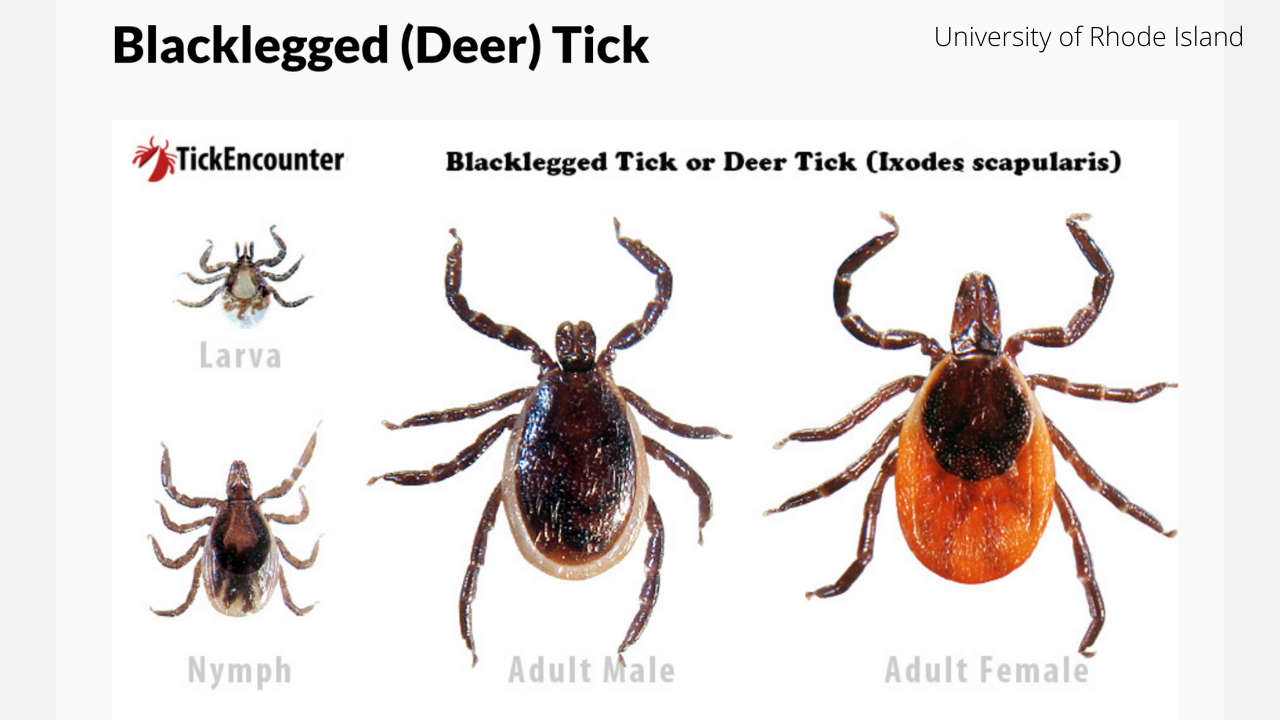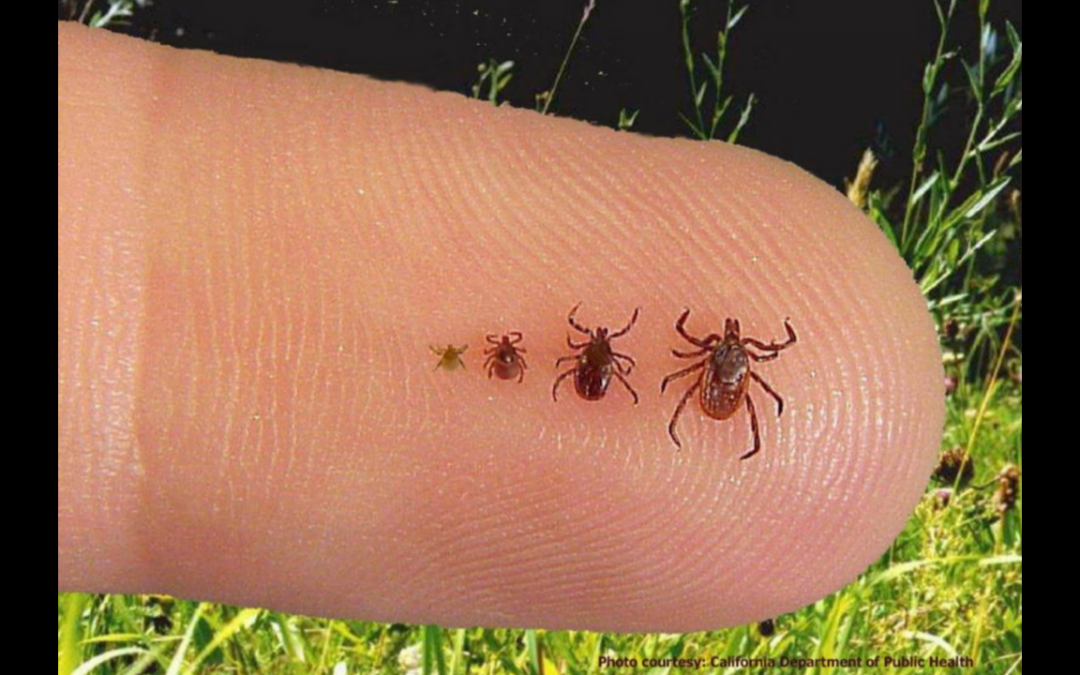The warmer weather encourages everyone to get outside and enjoy the sun on their face but there is one creature who is waiting in the wings to greet us and our pets…the tick. Few pests inspire the level of paranoia and anxiety as ticks. They are small, making it difficult to feel them crawling on you and if not discovered quickly they latch onto your skin and suck your blood. Even worse…they also transmit diseases!
Thankfully, there are ways to minimize your contact with these pesky pests and natural repellents to ward them off.
When & Where Ticks Are Most Active
Ticks are found across all North America and can be active year-round especially in areas with mild winters. However, they are most active in the spring and summer months and often well into the fall (April-September) as they prefer warm humid temperatures.
Although most common in wooded and tall grassy areas, ticks can also be found in your own backyard as they hitch rides on migrating birds in the spring making their way into city landscapes. However, you can breathe a small sigh of relief knowing that only a few of the 700 known species are found to bite and transmit diseases to humans.
Signs & Symptoms of a Tick Bite
Ticks can carry a host of pathogens that can cause human disease. Lyme disease is the most well-known, however ticks can also carry STARI (Southern tick-associated rash illness), Rocky Mountain spotted fever (RMSF), and more.
Should you discover a tick attached to you, remove it immediately and if possible, save the tick in a sealable plastic bag and store it in the freezer. This will preserve the tick and allow you to present it to your physician should you develop symptoms at a later date.
A small bump or redness at the site of a tick bite that occurs immediately and resembles a mosquito bite is common. This irritation generally goes away in 1-2 days and is not a sign of Lyme disease or STARI.
Should you be bitten or suspect you have been bitten by a tick, the following are signs and symptoms to watch for.
- Fever, chills, headache, fatigue, muscle and joint aches, and swollen lymph nodes may occur in the absence of rash
- Rash
- The area may feel warm to the touch but is rarely itchy or painful
- The rash sometimes clears as it enlarges, resulting in a target or “bull’s-eye” appearance
If you are experiencing any of the above symptoms, consult your doctor or health physician and inform them that you suspect you have been bitten by a tick.

What to Expect if You Have Been Bitten by a Possible Lyme Disease Carrying Tick
Although not every bite from a tick transmits this infection, bites should be evaluated carefully since early detection and appropriate treatment are critical in effectively treating Lyme disease and preventing the potentially serious medical complications caused by this infection.
Blacklegged ticks are hard ticks identifiable by their black legs, red-orange body, and black scutum, which looks like a dot on the upper half of its shield. Should you be bitten by this tick or any other tick and develop symptoms, your physician will perform a blood test to look for antibodies associated with Lyme disease.
Untreated Lyme disease can cause:
- Chronic joint inflammation (Lyme arthritis), particularly of the knee
- Neurological symptoms, such as facial palsy and neuropathy
- Cognitive defects, such as impaired memory
- Heart rhythm irregularities
Antibodies can take weeks to develop after a bite and can persist in the blood for months or even years after the infection is gone, however, not all blacklegged ticks carry Lyme disease so it is vital to watch for any signs or symptoms of illness such as flu-like symptoms (chills, headaches, fever, fatigue), redness and swelling around the bite, a bulls-eye rash, muscle, and joint aches – consult your physician immediately should they appear.
Treatments for Lyme Disease
The most common treatment for Lyme disease is a course of antibiotics, however, you can support your recovery with the addition of natural supplements and foods that boost the immune system.
Immune Supportive Foods:
- Garlic – contains compounds, like allicin, that the body can metabolically transform to antioxidants
- Spinach – high in both Vitamin C, zinc, and is a good source of fiber that supports gut health
- Fish – salmon and other fatty fish contain high levels of Omega-3 fatty acids and are rich in Vitamin E and astaxanthin (a powerful antioxidant)
- Berries – an excellent source of antioxidants to help boost immune health
- Selenium-rich foods – tuna, halibut, sardines, turkey, chicken, or cottage cheese
- Vitamin C-rich foods – bell peppers, kiwifruit, strawberries, papaya, broccoli, cauliflower, Brussel sprouts, kale, mango, and citrus fruits
- Vitamin E-rich foods – including almonds, hazelnuts, and sunflower seeds
It is important to consume a fiber-rich diet to ensure optimal gut health as approximately 70% of our immune system is in our gut. This allows your body to absorb the nutrient-rich food you are consuming and allows for proper extraction which is your body’s natural detoxifier.
Try to avoid foods high in sugar, processed foods, foods high in saturated fats, trans-fatty acids/hydrogenated fats, and any foods that cause you to feel unwell. This may also include allergen-promoting foods such as gluten, dairy, nuts, etc.
To develop your individualized nutritional plan, contact me today!
Before and After You Go Outdoors
Before heading outside, there are four simple precautions and preventative measures you can take to protect yourself from ticks in your area.
Avoid areas where ticks are likely to hang out.
Ticks do not jump or fly, they simply hang out on a branch or long piece of vegetation waiting for a host to walk by. When walking or hiking in wooded areas, stick to the middle of the path to avoid brushing against long grasses. Avoid leaf litter and heavily bushed areas and when participating in outdoor activities such as picnics and sports, try to choose areas with lots of sunshine and low-cut grass.
Dress appropriately in bushy areas.
Wear light-colored clothing such as long pants tucked into your socks and a long-sleeved shirt. This will allow you to see the darker-colored ticks on your clothing before it makes its way to your skin. You may also choose to wear a hat and boots to ensure most of your skin is fully covered.
Use repellents on your skin and clothing.
Deet has long been used as a tick repellent along with Permethrin, however, both can be toxic to humans and pets so you may want to choose from the natural repellents listed below.
- 2-undecanone, which comes from the leaves and stems of wild tomato plants, bananas, cloves, ginger, guava, strawberries, and the perennial leaf vegetable Houttuynia cordata. 2-undecanone comes in both synthetic and natural forms and can be used on both skin and clothing.
- Essential Oils from rosemary, lemongrass, cedar, peppermint, clove bud, thyme, neem seed, blue tansy, and geraniol. Essential oils can be used directly on the skin, and it is recommended to try a mixture of different oils to find which works best for you.
After returning from outside, inspect both yourself and your pets for any ticks that may still be looking for a free meal. Remove and wash all clothing followed by a cycle in a hot clothes dryer.
Stay Informed
The best way to enjoy your time outdoors is to use the above precautions and to stay informed on the level of tick-borne illness, populations in your area, and the types of ticks in your zone so that you can avoid heavily infested areas.
The following app is available for public use to help track and identify ticks that may be present where you live.
- The Tick App – Your on-the-go tick expert monitoring tick populations within the USA.
Although ticks can strike fear in the most courageous of people, you can still enjoy the outdoors safely all year long by being prepared, avoiding long grass, heavily wooded areas, and leaf debris, and by being diligent on checking for ticks after your time outside.
Stay Health & Strong,
Dr. Michael Kaye
Sources
Jordan RA, et al. (2012). Efficacy of plant-derived and synthetic compounds on clothing as repellents against Ixodes scapularis and Amblyomma americanum (Acari: Ixodidae) [Abstract]
Christina A. Nelson, Catherine M. Hayes, Molly A. Markowitz, Jacqueline J. Flynn, Alan C. Graham, Mark J. Delorey, Paul S. Mead, Marc C. Dolan, The heat is on: Killing blacklegged ticks in residential washers and dryers to prevent tick borne diseases, Ticks and Tick-borne Diseases, Volume 7, Issue 5, 2016, Pages 958-963, ISSN 1877-959X,
Centers for Disease Control and Prevention, National Center for Emerging and Zoonotic Infectious Diseases (NCEZID), Division of Vector-Borne Diseases (DVBD) – Tick Removal – https://www.cdc.gov/ticks/removing_a_tick.html
Centers for Disease Control and Prevention, National Center for Emerging and Zoonotic Infectious Diseases (NCEZID), Division of Vector-Borne Diseases (DVBD) – Signs and Symptoms of Untreated Lyme Disease – https://www.cdc.gov/lyme/signs_symptoms/index.html



